provides functions for Vector Data and Raster DataCreate Thematic Map. The supported Themtic Types are as follows:
- Unique-Values Map: It classifies the elements with the same thematic value into one category, and sets a rendering style for each category, such as color or symbol. The elements with the same thematic value adopt the same rendering style, so as to distinguish different categories.
- Graudated Colors Map: The thematic value is divided into multiple range segments according to a certain segmentation method, and the features are assigned to one of the range segments according to their respective thematic values. The features in the same range segment are displayed with the same color or Marker Style.
- Thematic Label Map: It is mainly used for marking on the map, that is, marking objects such as points, lines, and surfaces with thematic values, such as marking information such as scenic spot names.
- Statistical Thematic Map: a statistical chart is drawn for each feature to reflect the magnitude of its corresponding thematic value.
- Graduated Symbols Map: a group of Graduated Symbols are used to represent the quantitative characteristics of the elements on the map according to a certain classification method, so as to present the relative relationship of the quantitative characteristics among the elements.
- Dot Density Map: Use dots of a certain size and the same shape to represent the distribution range, quantitative characteristics and distribution density of the phenomenon. The number of points and the meaning they represent are determined by the content of the map. The more and denser the number of points, the greater the density or concentration of the things or phenomena represented by the reflection data in the region.
- Custom Thematic Map: Create the Custom Thematic Map through the CustomProperty field, and set the display style according to the numeric field value and the style of the corresponding ID number in the symbol library, so as to express the Data Information more freely.
- Grid Graudated Colors Map: The attribute values of pixels in Raster Dataset are divided into multiple range segments, and the pixels with cell values in the same range segment are displayed in the same color.
- Grid Unique-Values Map: The cells with the same attribute values in the Raster Dataset are grouped into one category, and a color is set for each category to distinguish different categories.
1. Thematic variable and thematic values
Thematic variable is a field expression used to Create Thematic Map. For Vector Data, the field expression can be a single field or a mathematical expression composed of a single or multiple fields. For example, if Pop _ 2006 is the field of population in 2006 and Area is the field of area of each city, then the expression Pop _ 2006/Area can be used as the Thematic variable of the thematic map when making the Graudated Colors Map.
Thematic map can express the information of one or more thematic variables, usually Unique-values Map, Graudated Colors Map, Dot Density Map, Both the Graduated Symbols Map and the Thematic Label Map are created based on a Thematic variable; The Statistical Thematic Map can be based on multiple Thematic variables, for example, you can display the population and the area of the city in a pie Statistical Thematic Map. In particular, a Thematic variable can represent the contents of multiple Property Fields in the form of a field expression.
Thematic variable corresponds to a value called a thematic value. Thematic values can be numeric data or non-numeric data (such as the type of Land Use, the owner of the house, etc.). Non-numerical data is generally used to make Unique-values Map or Thematic Label Map, while numerical data can be used to make various types of thematic maps.
For Raster Data, the Thematic variable is the pixel in the Raster Dataset, that is, the Thematic value is the attribute value of the pixel in the Raster Dataset.
2.About Layers, Normal Layers, and Thematic Layers
When the Dataset is loaded and displayed in the Map, a layer is formed, and the layer is a visual display of the Dataset. According to the display style, layers can be divided into Normal Layer and Thematic Layer. The Normal Layer uses a single style to render the layer, while the Thematic Layer is based on the Thematic variable and uses the Thematic style to render.
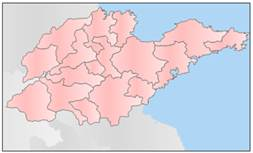 |
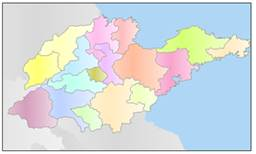 |
| Figure: Normal Layer | Figure: Thematic layer |
One Dataset can correspond to multiple thematic maps. The following figure shows the Thematic Label Map and Unique-values Map made for the data of Shandong Province according to the city names, and displays them in one Map.
The Scale with Map Zoom function is provided when browsing the layer, that is, when the layer is zoomed in or out, the size of the Marker Style of the feature will be zoomed in or out accordingly. When the Thematic Label Map is zoomed in, the label is also zoomed in.
Note: The method of setting Scale with Map Zoom is only valid for styles such as symbols or fonts with size and line types with thickness, but not for styles such as color.
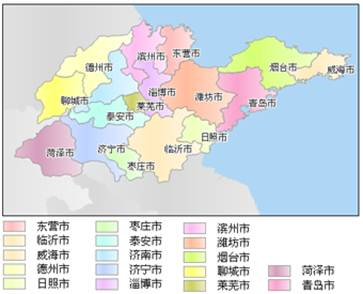 |
| Figure: Make two thematic maps for the same data |
3. About thematic map sub-items
Many types of thematic maps have the concept of thematic map sub-items, and the corresponding thematic map sub-items of different types of thematic maps have different meanings. Currently, Themtic Types with thematic map subitems include Unique-values Map, Statistical Thematic Map, Graudated Colors Map, and Thematic Label Map. Grid Graudated Colors Map,Grid Unique-values Map。 The elements contained in a subitem are considered as a whole, and the elements in the subitem will change when Style Settings is performed on the subitem.
- Unique-Values Map classifies the features with the same thematic values, and sets a rendering style for each category, where each category is a thematic map sub-item. For example, when Unique-Values Map is used to make an administrative division map, the Name field represents the name of a province/municipality directly under the Central Government and is used as a Thematic variable. If the field value of this field has five different values in total, the administrative division map has five thematic map subitems. The value of the element Name field is the same within each of these children.
- Graudated Colors Map is to divide the thematic value into multiple range segments according to a certain segmentation method, and the elements are allocated to one of the segments according to the corresponding thematic value, and the elements in the same range segment are displayed with the same color, fill, symbol and other styles. Each of these range segments is a Graudated Colors Map subkey.
- Thematic Label Map Use thematic values to label objects such as points, lines, and surfaces. It is worth noting that Thematic Label Map allows users to Bounds Settings segments. Labels in the same range segment have the same display style, and each range segment is a thematic map sub-item.
- Statistical Thematic Map Multiple thematic values can be plotted on a statistical chart, so that multiple numerical variables can be analyzed and counted at one time. The number of sub-items in the thematic map is the number of Thematic variables in the thematic map. For example, a 3D Bar Chart has two Thematic variables, one of which is the field of urban population (representing the number of urban population). The other Thematic variable is the field Rural population (representing the number of rural population). Then there are two sub-items in the thematic map of the Statistical Thematic Map, which are the statistical map corresponding to the value of the field of urban population in the three northeastern provinces and the statistical map corresponding to the value of the field of rural population.
- Grid Graudated Colors Map is similar to Graudated Colors Map, but differs in that the Operation object of Graudated Colors Map is Vector Data. The Operation object of the Grid Graudated Colors Map is Raster Data. Accordingly, the subitem of the Grid Graudated Colors Map is divided into different range segments according to a certain segmentation mode.
- Grid Unique-Values Map is to classify the pixels with the same attribute value into one class, and each class is a thematic map sub-item.
4.About Display Filter
During Create Thematic Map, the Display Filter function can selectively display some elements according to the Filter set by the user, so as to focus on the elements of interest. Users can set Filter through the standard SQL Expression, and the elements that do not meet the conditions will be filtered out. For Example, when displaying the sales amount of each chain store of a large supermarket in Graduated Symbols Map, use SQL Expression: (Sales _ 06-Sales _ 05)/Sales _ 05 < Is no less than 10% annual growth in sales will not be shown in the results map.
5.About Color Scheme
For Themtic Type with thematic map sub-items, SuperMap provides a set of Color Scheme, which can provide a color scheme for the color rendering of all thematic map sub-items of the thematic map, and will reasonably allocate a rendering color to each sub-item according to the number of thematic map sub-items.
There are three types of Color Scheme predetermined by the system, as shown in Table 2.1. They are the gradation of one color, the gradation between two colors, and the gradation between multiple colors.
| Color Scheme type | |
| The gradation of a color. |  |
| Gradient between two colors | 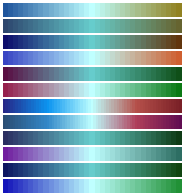 |
| Gradient between multiple colors | 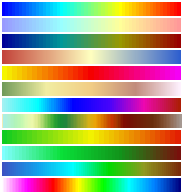 |
6. Import and export of thematic styles
In , the Style Settings of the thematic map can be exported to a *.xml file. Users can easily view and Modify Thematic Map Style Settings information through an XML file.
The XML file records all the setup information about the thematic map, such as, The *.xml file of the Thematic Label Map will record all the Style settings of the Thematic Label Map, such as Themtic Type, visible scale bar, and Label Style. And Thematic variable, which is used to make Thematic Label Map.
When importing a thematic style *.xml file, please note: First, it must be applied to thematic maps of the same type. For example, *.xml exported from a Thematic Label Map can only be applied to a Thematic Label Map; Secondly, in addition to the style settings, the XML file also has settings such as Thematic variable. Unless the data referenced by the thematic map imported from the *.xml file is the same as the data referenced by the thematic map exported from the *.xml file, the inconsistent information needs to be modified before it can be applied.



